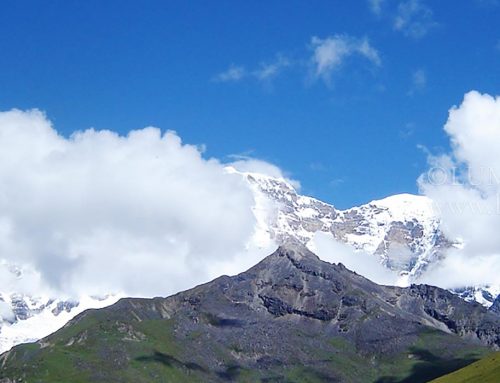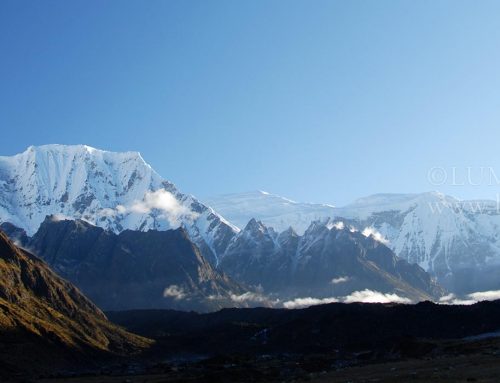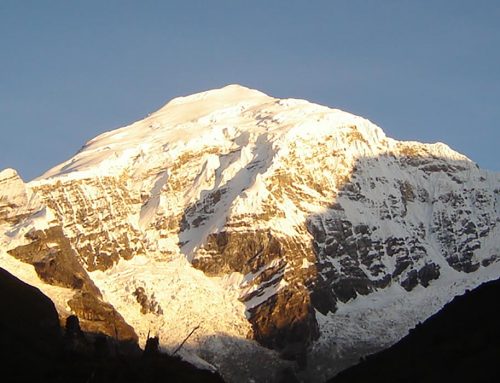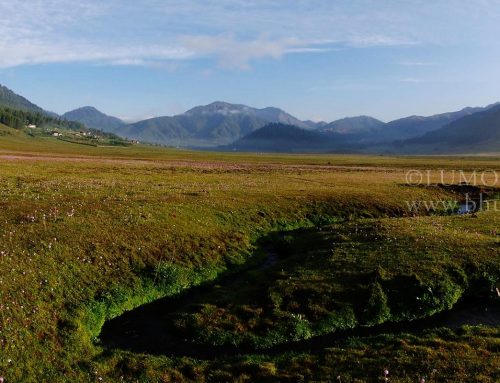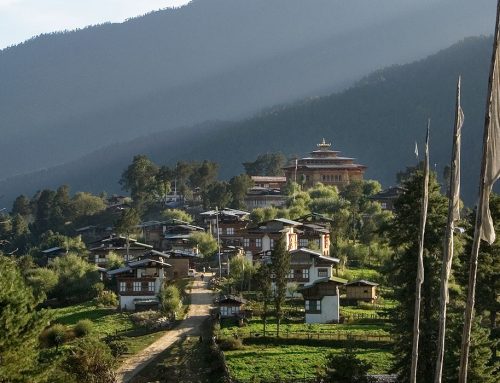- Duration: 13 nights / 14 days.
- Accommodation: Hotels, Resorts and Tents.
- Activity Type: Walking, Trekking & Tour.
- Difficulty Level: Strenuous.
- Highest altitude: 3360 m
- Group size: Minimum 2 pax
- Best Months for the Trek: March – May, September – 2nd Week of December.
- Visit to the tallest statue of Buddha in Bhutan, Memorial Chorten, and Punakha Dzong
- A panoramic view of the higher Himalayas from the Dochu La Pass (3140m)
- An external view of Chimi Lhakhang (Temple of Fertility) and Wangduephodrang Dzong
- A farm house visit
- Excursion to the famous Taktsang Monastery (Tiger’s Nest)
- Visit to Drugyal Dzong, Kichu Monastery, Jambay Lhakhang , Kurjey Lhakhang, Trongsa Dzong, Tamshing Lhakhang Jakar Dzong, and the Membartsho Lake
- Visit to Phobjikha/Gangtey Valley, the roosting ground for the rare Black-necked Crane
- Excursion to beautiful Ura valley and Ura Temple (3100m)
DAY 01. ARRIVE AT PARO BY DRUK AIR:
The flight into Paro is a befitting introduction to the spectacular beauty of Bhutan. In clear weather, you will be able to see some of the world’s highest peaks as you fly into Paro. As the aircraft prepares for landing, you will be surrounded by the lush green valleys. On landing, your Bhutanese escort from Druk & Drukpa Travel will greet you at the exit terminal, and then drive you the short distance to the hotel. In the evening, you are free to stroll in the town for photography. Overnight in a hotel.
DAY 02. PARO SIGHTSEEING:
Your exploration of the Thunder Dragon kingdom will begin with a short drive in the morning to the ruins of the Drukgyal Dzong (Victory Fortress). Built in 1647 by Zhabdrung Ngawang Namgyal, father and unifier of medieval Bhutan, the dzong was almost completely destroyed by a fire in the early 1950s and has been in ruins ever since. You will get an unforgettable view of Mt. Jhomolhari (7,314 m) from Drukgyal. On the way back, you will visit Kichu Lhakhang, built in 659 A.D. by the Tibetan king Srongsen Gampo. After lunch, visit Ta Dzong, an ancient watchtower, which now houses the National Museum. Below the museum is the Paro Rimpung Dzong, built in 1646 by Shabdrung Ngawang Namgyal. A short walk takes you to the base of the dzong and you will cross the Pachhu River on a traditional cantilever bridge. If we are lucky, we may catch an archery match in action close by. The evening ends with a walk through Paro’s main streets.
DAY 03. PARO, EXCURSION TO TAKTSANG MONASTERY:
After breakfast a short drive will take you to Satsam Chorten, from where you start your 2-hour hike to view the spectacular Taktsang (Tiger’s Nest) monastery. The trail climbs through beautiful pine forests. You will stop for a rest and light refreshments at the Taktsang Zakhang (cafeteria) and then walk a short distance until you see, clearly and seemingly within reach, the famed Taktsang Monastery. Built in the 1600s, this incredible monastery clings to the edge of a sheer rock cliff. It is said that Guru Padmasambhava, the tantric mystic who brought Buddhism to Bhutan, came to Taktsang riding on a tigress. Lunch will be served at the cafeteria. After Lunch, we go back to the hotel, check out and drive to Thimphu. Overnight in a hotel.
DAY 04. THIMPHU SIGHTSEEING:
The day begins with a visit to the National Memorial Chorten, built in honour of the late King Jigme Dorji Wangchuck, and the Dupthop Lhakhang, one of the few surviving nunneries in Bhutan. We then visit the National Library, which displays the ancient Buddhist manuscripts, and the Painting School where the traditional Bhutanese art is still kept alive. After lunch we drive to the National Institute of Traditional Medicine and to Lungtenzampa to observe the royal silver smiths and a traditional paper factory. Other highlights of the sightseeing include a visit to the Tashichhodzong, seat of the national government and the Central Monastic Body, including the summer residence of the Je Khenpo (Chief Abbot of Bhutan). We then drive to Simtokha Dzong, the oldest Dzong of Bhutan built by Shabdrung in 1627, and finally visit the Handicrafts Emporium where you may buy souvenirs. Overnight in a hotel.
DAY 05. THIMPHU – PUNAKHA (76 KM, 3-HOUR DRIVE):
After breakfast, we will drive to Punakha through Dochula Pass. If the weather is clear, you will see a spectacular view of the higher Himalayas at Dochula. After lunch at Punakha, you will visit the Punakha Dzong. Built in 1637 by Zhabdrung Ngawang Namgyal, the sprawling fortress is situated between Pho Chu (Male River) and Mo Chu (Female River). For many years until the time of the second king, it served as the seat of the government. There was a smaller building here called Dzong Chu (Small Dzong) that housed a statue of Buddha. It is said that Zhabdrung ordered the architect, Zowe Palep, to sleep in front of the statue, and while Palep was sleeping, the Zhabdrung took him in his dreams to Zangtopelri and showed him the palace of Guru Rimpoche. From this vision, the architect conceived the design for the new Dzong. The Dzong was named Druk Pungthang Dechen Phodrang (Palace of Great Happiness). The war materials, mostly weapons and protective gears, captured during the battle with Tibetans are preserved here. Punakha is still the winter residence of Je Khenpo. The first National Assembly of Bhutan was convened here in 1952. Overnight in a hotel.
DAY 06. PUNAKHA – TRONGSA – BUMTHANG:
We start early to Bumthang. On the way, we will stop for a while to view the Chime Lhakhang, built by Lama Drukpa Kuenley, more popularly known as the Divine Madman. The Temple is also known as “The Temple of Fertility”. In Wangduephodrang, we will view the Dzong, built in 1638 and situated on a narrow ridge at the confluence of Mochhu and Tangchhu rivers. Lunch will be served at Trongsa. You will then visit the Trongsa Dzong, the most impressive fortress in Bhutan, built in 1644 by Chogyal Minjur Tempa, the official who was dispatched by Zhabdrung to unify eastern Bhutan. The fortress was expanded at the end of the 17th century by Desi Tenzin Rabgay. Trongsa Dzong is the ancestral home to the present Royal Family and first two hereditary kings ruled Bhutan from this Dzong. We will then visit the Ta Dzong, an ancient watch tower, now a monarchy museum. We will then drive to Bumthang. Overnight in a hotel.
DAY 07. BUMTHANG SIGHTSEEING:
After breakfast, you will visit Jakar Dzong, which literally means “The Castle of White Bird”. The present structure was built in 1667. You will visit Jambay Lhakhang, said to have been built by King Srongsen Gampo of Tibet in 659 AD in the same year as Kichu Lhakhang in Paro. The temple was visited by Guru Rinpoche during his visit to Bumthang. Under the temple is said to be a lake in which Guru Rinpoche hid several Terma (sacred treasures). In October every year one of the most spectacular festivals, Jambay Lhakhang Drup, is staged here. You will then visit Kurjey Lhakhang that is named after the body print of Guru Rinpoche, built in 1652 by Minjur Tempa. You will then visit Tamshing Lhakhang, established in 1501 by Pema Lingpa and is the most important Nyingmapa temple in the kingdom. After lunch, an excursion to Membar Tsho, literally “The Burning Lake”, will be scheduled. In the evening, you may visit the Swiss cheese factory. Overnight in a hotel.
START OF BUMTHANG CULTURAL TREK.
DAY 08. JAKAR – NAGANG LAKHANG:
The trek route follows the Chamkhar Chu River through many villages and temples. This is a very easy and relaxing day. Arrive at the village camp at the altitude of 2900 meters. Walking time around 6 hours.
DAY 09: NGANG LHAKANG – UGYENCHHOLING:
The trail ascends gradually toward the Phephe La Pass through the forest of juniper until you arrive at the pass at an altitude of 3340 meters. You will then descend to Tang Valley, finally arriving at Ugyenchholing village. Camp by the side of the river at the altitude of 2850 meters. Walking time around 7-8 hours.
DAY 10. UGYENCHHOLING – JAKAR:
Morning walk up to the Ugyenchholing Dzong and the surrounding village, then drive to Jakar following the Tangchhu River until you arrive at the main road junction. On the way visit the Membertsho Lake, where Terton Pemalingpa, the great treasure revealer, is supposed to have discovered religious treasures hidden by Guru Rinpoche in the 12th century. This lake is very sacred and many Bhutanese visit it during auspicious days to offer prayers and butter lamps. Overnight in a lodge.
DAY 11. BUMTHANG (EXCURSION TO URA VALLEY):
After breakfast, you drive to Ura valley. Packed Lunch will be served. In the evening, drive back to Bumthang. Overnight in Bumthang.
DAY 12: BUMTHANG – PHOBJIKHA VALLEY (GANGTEY):
After breakfast, you will be driven to the beautiful valley of Phobjikha/Gangtey. Visit Gangtey Gompa Monastery from outside. Gyaltse Pema Thinley, the grandson and mind reincarnation of Pema Lingpa, founded the Temple in 1613. It is a Nyingma monastery and is affiliated to other Nyingma monasteries including Tamshing in Bumthang. Explore Phobjikha valley, the winter roosting ground for the rare Black-necked Cranes. Overnight at a guesthouse.
DAY 13. GANGTEY – THIMPHU:
After breakfast, you will come back to Thimphu and after lunch, you will visit the tallest statue of Buddha in the world and a mini zoo. In the evening, you may stroll around Thimphu city for shopping and leisure. Overnight in a hotel.
DAY 14. THIMPHU – PARO:
You will be driven to the airport early in the morning.
Optional activities that you can add in the program:
- Visit to Martha (special yak wool) Factory
- Visit to a Bhutanese Farm House
- Rafting in Pho Chu (Punakha)
- Hike to Dzongdrakha in Paro
- Excursion to Chele La Pass in Paro
- Hike to Gogona Valley in Gangtey
- Cultural show in Thimphu
Cost inclusive of:
- All Meals [Breakfast /Lunch/Dinner]
- Accommodation [Twin Sharing] Single Room Supplement Extra US $: 40 per room per night.
- All transportation within the country including airport transfers.
- Royalty & Govt. Taxes
- Entrance fees for Museums and Monuments only
- Visa Fee
- Airport tax
- Contribution to Tourism Development Fund
- Guide
- Sightseeing
While on trek, cost covers:
- Nature Recreation and Ecotourism Division (NRED) Nu.1000
- 3 meals a day
- Service of cook & helper
- Guide, sleeping tent
- Mess Tent, Kitchen Tent & Toilet Tent
- Ponies to carry supplies
- Royalty
- We will provide you with sleeping mats but you have to bring your own sleeping bags.
Cost exclusive of:
- Druk Air fare
- Insurance Premiums
- Payments for service provided on a personal basis
- Cost for any services not mentioned in the “Cost Include Head”
- Cost incurred due to mishaps, strikes, political unrest, etc.
- Personal expense in items such as laundry, soft drinks, camera charges, bottled water, incidentals, portage, bellboy charges, tips or any other services
Personal clothing: strong normal clothing (according to season). Preferably cotton, even for summer, woolen clothing for the evening and winter.
For Trekking, one must bring:
- Strong comfortable trekking boots – water-resistant for the rainy period of June-August
- Sunscreen
- Flash light
- Rain coat (especially for rainy period – June-August)
- Head gear/hat/cap for sun and rain protection
- Water pills – for extra caution in purifying stream; (boiled water is provided at all times during the trek)
- Aspirin – incase of altitude sickness
- Lots of socks
- Warm clothes
OPTIONAL ITEMS
- Sunglasses
- Headgear
- Folding umbrella (only for wet months — July and August)
- One towel
- Pillow case
- Wet-packed tissue paper
- Pillow



